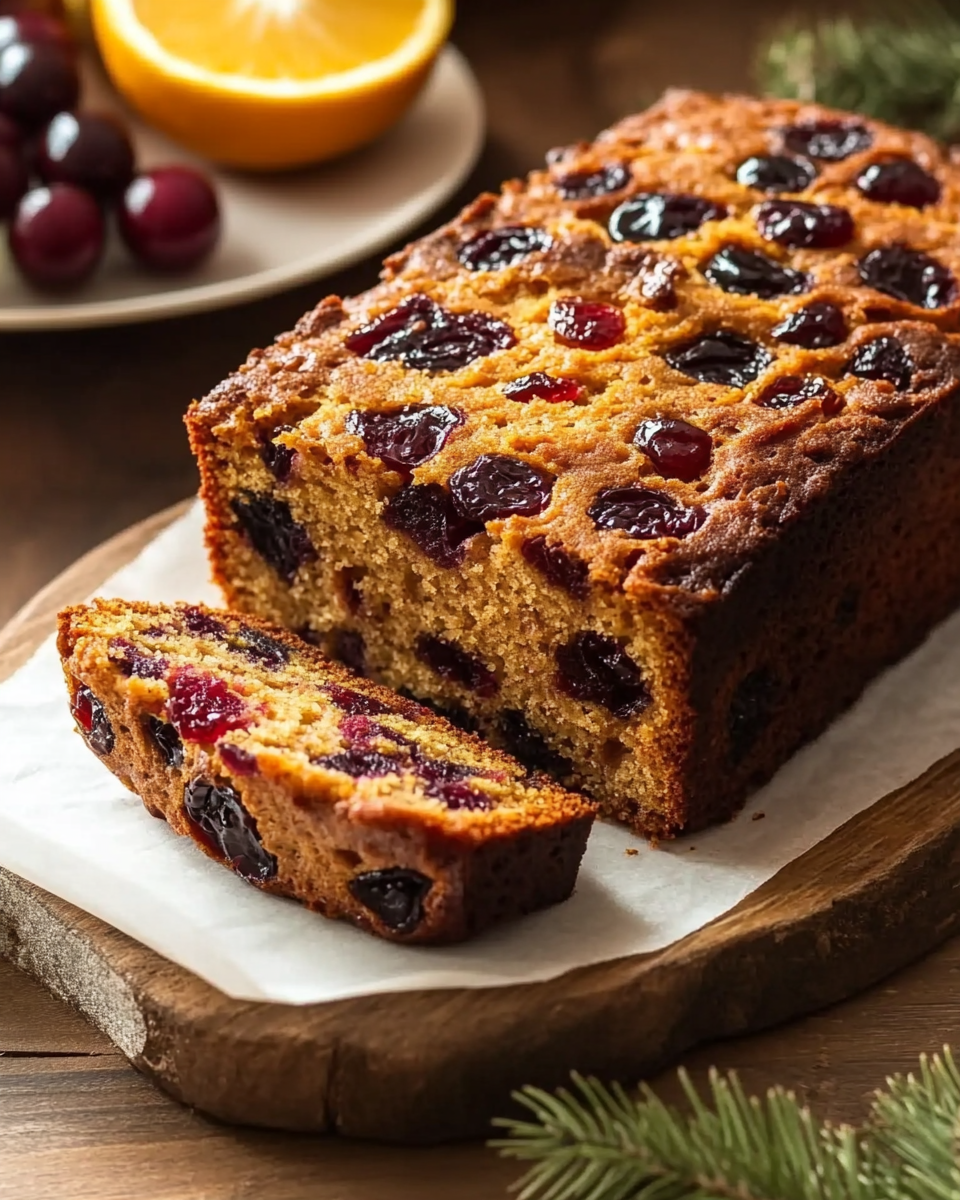This holiday classic has stood the test of time with its dense, moist texture and vibrant mix of fruits and nuts. Grandma’s Fruit Cake is rich, warmly spiced, and kissed with a splash of brandy for that traditional depth of flavor. It’s a staple on holiday tables and a true celebration of cherished seasonal ingredients. Not only does this cake taste better as it rests and matures, but it also makes a thoughtful, homemade gift wrapped in parchment or cheesecloth. It’s a wonderful dessert to enjoy with a warm drink or to share with friends and family. Whether you love it for nostalgia or flavor, this fruit cake is an iconic treat that brings warmth to every slice.
Full Recipe:
Ingredients:
-
1 cup unsalted butter, softened
-
1 cup brown sugar, packed
-
4 large eggs
-
2 cups all-purpose flour
-
1/2 teaspoon baking powder
-
1/4 teaspoon salt
-
1 teaspoon ground cinnamon
-
1/2 teaspoon ground nutmeg
-
1/4 teaspoon ground cloves
-
1 cup chopped walnuts or pecans
-
1 cup chopped candied cherries
-
1 cup chopped candied pineapple
-
1 1/2 cups raisins or currants
-
1/2 cup brandy or orange juice
-
Zest of 1 orange
-
Zest of 1 lemon
Directions:
-
Preheat oven to 300°F (150°C). Grease and line a 9×5-inch loaf pan with parchment paper.
-
In a large bowl, cream together the butter and brown sugar until light and fluffy.
-
Add eggs one at a time, beating well after each addition.
-
In a separate bowl, whisk together flour, baking powder, salt, cinnamon, nutmeg, and cloves.
-
Gradually mix dry ingredients into the wet mixture until just combined.
-
Fold in the nuts, candied fruits, raisins, brandy (or orange juice), and citrus zest.
-
Spoon the batter evenly into the prepared loaf pan.
-
Bake for 2 to 2.5 hours or until a toothpick inserted in the center comes out clean.
-
Let cool completely in the pan. Optionally, wrap in cheesecloth soaked in brandy and store in an airtight container for several days before serving.
Prep Time: 30 minutes | Cooking Time: 2 hours 15 minutes | Total Time: 2 hours 45 minutes
Kcal: 420 kcal | Servings: 10 servings
The Rich Tradition of Grandma’s Fruit Cake: A Timeless Holiday Classic
When it comes to holiday desserts, few confections evoke as much nostalgia and tradition as the classic fruit cake. Whether wrapped lovingly in cheesecloth and soaked in brandy or simply served as a warm slice beside a mug of tea, Grandma’s Fruit Cake is a staple of winter celebrations in households around the world. Though modern trends may lean toward lighter fare or gluten-free variations, the dense, rich fruit cake remains a beloved treat passed down through generations.
In this article, we’ll explore the deep-rooted history of fruit cake, its symbolic presence during the holidays, tips for perfecting it at home, and why it’s making a modern comeback. Whether you’re a long-time fan or just discovering it, this is a dessert worth revisiting and cherishing.
A Slice of History: The Origins of Fruit Cake
Fruit cake is far from a new creation it boasts centuries of culinary history. Originating in ancient Rome, early versions included pomegranate seeds, pine nuts, and raisins mixed into barley mash. As trade expanded through the Middle Ages and sugar became more readily available, preserved fruits were introduced, and the cake evolved into the sweet, dense version we recognize today.
In the 18th and 19th centuries, fruit cake became associated with special occasions due to its richness and cost of ingredients. It was often served at weddings, Christmas gatherings, and other significant events. British and American households embraced fruit cake, and families would pass down their own unique versions each with a special combination of fruits, nuts, and spices, often soaked in spirits to extend its shelf life.
This tradition of longevity and richness is one of the reasons Grandma’s Fruit Cake has endured. It symbolizes abundance, celebration, and the passing of legacy through flavor and memory.
Why It Became a Holiday Favorite
Fruit cake holds a particularly firm place in holiday culinary traditions for good reason. The holiday season is a time for warmth, indulgence, and connecting with loved ones and fruit cake offers all of these in a single slice.
The ingredients themselves candied cherries, raisins, brandy, citrus zest, and warm spices like cinnamon and cloves evoke the cozy aromas and tastes of the season. The slow baking process and long maturation time align with the rhythms of the winter months, encouraging cooks to prepare the cake in advance and allow it to develop its deep, complex flavor.
Wrapped up as a gift or enjoyed by the fire, fruit cake embodies everything the holidays represent: love, patience, tradition, and indulgence. For many, baking it is an act of honoring heritage.
The Flavor Profile: Rich, Spiced, and Deeply Layered
One of the most misunderstood aspects of fruit cake is its flavor. For some, commercial versions filled with artificial fruit and lacking texture have tarnished its reputation. However, a homemade version like Grandma’s offers a multi-dimensional taste experience.
The sweetness from dried and candied fruits is balanced by the depth of warm spices and a hint of bitterness from citrus zest. The brandy or orange juice adds moisture, complexity, and preservation qualities. Nuts provide a needed crunch, breaking up the dense, soft interior and adding earthiness.
Each bite offers something slightly different, which makes fruit cake one of the most exciting cakes for the palate. And over time, as the flavors meld and mature, the taste becomes even richer and more developed.
Soaking, Aging, and Storing: The Secret to Better Flavor
One of the defining features of a traditional fruit cake is its ability to age gracefully. In fact, many seasoned bakers argue that the cake reaches its peak flavor weeks or even months after it’s baked.
The technique of soaking the cake in brandy or another spirit and wrapping it in cheesecloth is an old one. This not only preserves the cake but enhances its moisture and flavor. Stored in a cool, dark place, a properly aged fruit cake becomes almost like a vintage wine deeper, more aromatic, and luxurious.
It’s this aging process that elevates Grandma’s Fruit Cake from a simple dessert to an artisanal delicacy. For those who prefer a non-alcoholic version, orange juice can be used for soaking, though it won’t preserve the cake as long as alcohol.
Common Mistakes and How to Avoid Them
Despite its forgiving nature, making a great fruit cake involves some careful attention. Here are a few common pitfalls to avoid:
1. Not preparing the fruit ahead of time
Soaking the dried fruit for a few hours or even overnight helps it rehydrate and prevents it from drawing moisture from the cake during baking.
2. Overbaking
Due to its dense composition, fruit cake can easily become dry if overcooked. A long, slow bake at a lower temperature is key, and always test with a toothpick or cake tester.
3. Skipping the wrap
Whether you’re using brandy or juice, wrapping the cake and allowing it to sit is essential. This helps lock in moisture and allows the flavors to meld beautifully.
4. Using too many fruits or spices
While it’s tempting to add every dried fruit in your pantry, the best fruit cakes balance flavors. Overdoing it can lead to a muddled taste. Simplicity, paired with quality ingredients, is best.
Modern Twists and Variations
Today’s bakers have embraced the tradition of fruit cake while also introducing modern updates. Gluten-free, vegan, and sugar-free versions are now common. Others opt for a tropical twist, using ingredients like dried mango, pineapple, and coconut. Still others enhance the flavor with chocolate chips, espresso powder, or even citrus liqueurs.
And the shape isn’t fixed either while the loaf is classic, mini fruit cakes, bundt-style rings, or even cupcakes are popular variations for easier serving and gifting.
Regardless of your twist, the essence of fruit cake remains: a lovingly crafted dessert meant to be savored slowly and shared generously.
Serving Suggestions and Pairings
Grandma’s Fruit Cake is incredibly versatile when it comes to serving. Here are a few ways to enjoy it:
-
With a hot beverage: A slice pairs wonderfully with tea, coffee, or mulled wine.
-
Toasted with butter: A lightly toasted slice with a pat of butter is a comforting morning treat.
-
With cheese: Surprisingly, fruit cake pairs beautifully with aged cheddar or creamy brie.
-
As a dessert course: Served with a dollop of whipped cream or crème fraîche, it’s a fitting end to a holiday meal.
The flavors in fruit cake are intense and complex, so it’s best served in thin slices each one packed with seasonal charm.
The Sentimental Value of Grandma’s Recipe
More than just a dessert, Grandma’s Fruit Cake is a culinary heirloom. It’s often made from a handwritten recipe card, spattered with decades of love and batter. It represents family, storytelling, holidays by the fireplace, and generations of memory baked into every bite.
Sharing this recipe is a way of preserving not just tradition but identity. It’s a reminder of a slower time, when recipes were crafted with patience, and flavors were meant to evolve with time.
Conclusion:
Though it’s sometimes maligned or misunderstood, Grandma’s Fruit Cake remains a testament to enduring culinary tradition. It may not be flashy, but it’s rich in flavor, history, and heart. It’s a recipe that has earned its place on holiday tables not just for its taste, but for what it represents: time-honored technique, thoughtful preparation, and the spirit of giving.
Whether you’re making it for the first time or the fiftieth, let this fruit cake remind you that some things are worth the wait. A true labor of love, it’s the kind of recipe that nourishes not just the body, but the soul.






